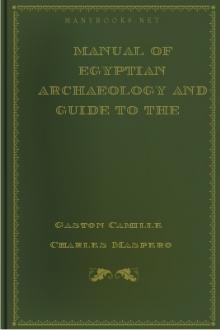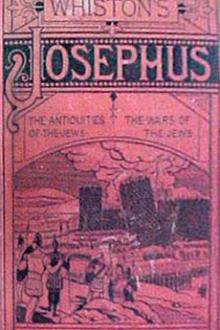Manual of Egyptian Archaeology and Guide to the Study of Antiquities in Egypt by Gaston Maspero (i have read the book txt) 📕

107. Wall-scene from temple of Denderah
108. Obelisk of Heliopolis, Twelfth Dynasty
109. Obelisk of Begig, Twelfth Dynasty
110. "Table of offerings" from Karnak
111. Limestone altar from Menshîyeh
112. Wooden naos, in Turin Museum
113. A mastaba
114. False door in mastaba
115. Plan of forecourt, mastaba of Kaäpir
116. Plan of forecourt, mastaba of Neferhotep
117. Door in mastaba façade
118. Portico and door of mastaba
119. Plan of chapel, mastaba of Khabiûsokari
120. Plan of chapel, mastaba of Ti
121. Plan of chapel, mastaba of Shepsesptah
122. Plan of chapel, mastaba of Affi
123. Plan of chapel, mastaba of Thenti
124. Plan of chapel, mastaba of Red Scribe
125. Plan of chapel, mastaba of Ptahhotep
126. Stela in mastaba of Merrûka
127. Wall-scene from mastaba of Ptahhotep
128. Wall-scene from mastaba of Ûrkhûû
129. Wall-scene from mastaba of Ptahhotep
130. Plan of serdab in mastaba at Gizeh
131. Plan of serdab and
Read free book «Manual of Egyptian Archaeology and Guide to the Study of Antiquities in Egypt by Gaston Maspero (i have read the book txt) 📕» - read online or download for free at americanlibrarybooks.com
- Author: Gaston Maspero
- Performer: -
Read book online «Manual of Egyptian Archaeology and Guide to the Study of Antiquities in Egypt by Gaston Maspero (i have read the book txt) 📕». Author - Gaston Maspero
At Luxor (fig. 86), the progress went on methodically enough under Amenhotep III. and Seti I., but when Rameses II. desired to add to the work of his predecessors, a bend in the river compelled him to turn eastwards. His pylon is not parallel to that of Amenhotep III., and his colonnades make a distinct angle with the general axis of the earlier work. At Philae (fig. 87) the deviation is still greater. Not only is the larger pylon out of alignment with the smaller, but the two colonnades are not parallel with each other. Neither are they attached to the pylon with a due regard to symmetry. This arises neither from negligence nor wilfulness, as is popularly supposed. Fig 88.--Plan of Speos, Kalaat Addah, Nubia. Fig 88.--Plan of Speos, Kalaat Addah, Nubia.
The first plan was as regular as the most symmetrically-minded designer could wish; but it became necessary to adapt it to the requirements of the site, and the architects were thenceforth chiefly concerned to make the best of the irregularities to which they were condemned by the configuration of the ground. Such difficulties were, in fact, a frequent source of inspiration; and Philae shows with what skill the Egyptians extracted every element of beauty and picturesqueness from enforced disorder.
The idea of the rock-cut temple must have occurred to the Egyptians at an early period. Fig 90.--Plan of the Great Speos, Abû Simbel. Fig 90.--Plan of the Great Speos, Abû Simbel.
They carved the houses of the dead in the mountain side; why, therefore, should they not in like manner carve the houses of the gods? Yet the earliest known Speos-sanctuaries date from only the beginning of the Eighteenth Dynasty. They are generally found in those parts of the valley where the cultivable land is narrowest, as near Beni Hasan, at Gebel Silsileh, and in Nubia. All varieties of the constructed temple are found in the rock-cut temple, though more or less modified by local conditions. The Speos Artemidos is approached by a pillared portico, but contains only a square chamber with a niche at the end for the statue of the goddess Pakhet. Fig 91.--Speos of Hathor, Abû Simbel. Fig 91.--Speos of Hathor, Abû Simbel.
At Kalaat Addah (fig. 88), a flat narrow façade (A) faces the river, and is reached by a steep flight of steps; next comes a hypostyle hall (B), flanked by two dark chambers (C), and lastly a sanctuary in two storeys, one above the other (D). The chapel of Horemheb (fig. 89), at Gebel Silsileh, is formed of a gallery parallel to the river (A), supported by four massive pillars left in the rock. From this gallery, the sanctuary chamber opens at right angles. At Abû Simbel, the two temples are excavated entirely in the cliff. The front of the great speos (fig. 90) imitates a sloping pylon crowned with a cornice, and guarded as usual by four seated colossi flanked by smaller statues. Fig 92.--Plan of the upper portion of the temple of Deir el Baharî, showing the state of the excavations, the Speos of Hathor (A); the rock-cut sanctuary (B); the rock-cut funerary chapel of Thothmes I. (C); the Speos of Anubis (D); and the excavated niches of the northern colonnade. Reproduced from Plate III. of the Archaeological Report of the Egypt Exploration Fund for 1893-4. Fig 92.--Plan of the upper portion of the temple of Deir el Baharî, showing the state of the excavations, the Speos of Hathor (A); the rock-cut sanctuary (B); the rock-cut funerary chapel of Thothmes I. (C); the Speos of Anubis (D); and the excavated niches of the northern colonnade. Reproduced from Plate III. of the Archaeological Report of the Egypt Exploration Fund for 1893-4.
These colossi are sixty-six feet high. The doorway passed, there comes a first hall measuring 130 feet in length by 60 feet in width, which corresponds to the usual peristyle. Eight Osiride statues backed by as many square pillars, seem to bear the mountain on their heads. Beyond this come (1) a hypostyle hall; (2) a transverse gallery, isolating the sanctuary, and (3) the sanctuary itself, between two smaller chambers. Eight crypts, sunk at a somewhat lower level than that of the main excavation, are unequally distributed to right and left of the peristyle. Fig 93.--Plan of temple of Seti I., at Abydos. Fig 93.--Plan of temple of Seti I., at Abydos.
The whole excavation measures 180 feet from the doorway to the end of the sanctuary. The small speos of Hathor, about a hundred paces to the northward, is of smaller dimensions. The façade is adorned with six standing colossi, four representing Rameses II., and two his wife, Nefertari. The peristyle and the crypts are lacking (fig. 91), and the small chambers are placed at either end of the transverse passage, instead of being parallel with the sanctuary. The hypostyle hall, however, is supported by six Hathor-headed pillars. Where space permitted, the rock-cut temple was but partly excavated in the cliff, the forepart being constructed outside with blocks cut and dressed, and becoming half grotto, half building. In the hemi-speos at Derr, the peristyle is external to the cliff; at Beit el Wally, the pylon and court are built; at Gerf Husein and Wady Sabûah, pylon, court, and hypostyle hall are all outside the mountain, The most celebrated and original hemi-speos is that built by Queen Hatshepsût, at Deir el Baharî, in the Theban necropolis (fig. 92),[19] The sanctuary and chapels which, as usual, accompany it, were cut about 100 ft. above the level of the valley. In order to arrive at that height, slopes were made and terraces laid out according to a plan which was not understood until the site was thoroughly excavated.
Between the hemi-speos and the isolated temple, the Egyptians created yet another variety, namely, the built temple backed by, but not carried into, the cliff. The temple of the sphinx at Gizeh, and the temple of Seti I. at Abydos, may be cited as two good examples. I have already described the former; the area of the latter (fig. 93) was cleared in a narrow and shallow belt of sand, which here divides the plain from the desert. It was sunk up to the roof, the tops of the walls but just showing above the level of the ground. The staircase which led up to the terraced roof led also to the top of the hill. The front, which stood completely out, seemed in nowise extraordinary. It was approached by two pylons, two courts, and a shallow portico supported on square pillars. The unusual part of the building only began beyond this point. First, there were two hypostyle halls instead of one. These are separated by a wall with seven doorways. There is no nave, and the sanctuary opens direct from the second hall. This, as usual, consists of an oblong chamber with a door at each end; but the rooms by which it is usually surrounded are here placed side by side in a line, two to the right and four to the left; further, they are covered by "corbelled" vaults, and are lighted only from the doors. Behind the sanctuary are further novelties. Another hypostyle hall (K) abuts on the end wall, and its dependencies are unequally distributed to right and left. As if this were not enough, the architect also constructed, to the left of the main building, a court, five chambers of columns, various passages and dark chambers--in short, an entire wing branching off at right angles to the axis of the temple proper, with no counterbalancing structures on the other side. These irregularities become intelligible when the site is examined. The cliff is shallow at this part, and the smaller hypostyle hall is backed by only a thin partition of rock. If the usual plan had been followed, it would have been necessary to cut the cliff entirely away, and the structure would have forfeited its special characteristic--that of a temple backed by a cliff--as desired by the founder. The architect, therefore, distributed in width those portions of the edifice which he could not carry out in length; and he even threw out a wing. Some years later, when Rameses II. constructed a monument to his own memory, about a hundred yards to the northward of the older building, he was careful not to follow in his father's footsteps. Built on the top of an elevation, his temple had sufficient space for development, and the conventional plan was followed in all its strictness.
Most temples, even the smallest, should be surrounded by a square enclosure or temenos.[20] At Medinet Habu, this enclosure wall is of sandstone-- low, and embattled. The innovation is due to a whim of Rameses III., who, in giving to his monument the outward appearance of a fortress, sought to commemorate his Syrian victories. Elsewhere, the doorways are of stone, and the walls are built in irregular courses of crude bricks. The great enclosure wall was not, as frequently stated, intended to isolate the temple and screen the priestly ceremonies from eyes profane. It marked the limits of the divine dwelling, and served, when needful, to resist the attacks of enemies whose cupidity might be excited by the accumulated riches of the sanctuary. As at Karnak, avenues of sphinxes and series of pylons led up to the various gates, and formed triumphal approaches. The rest of the ground was in part occupied by stables, cellarage, granaries, and private houses. Just as in Europe during the Middle Ages the population crowded most densely round about the churches and abbeys, so in Egypt they swarmed around the temples, profiting by that security which the terror of his name and the solidity of his ramparts ensured to the local deity. A clear space was at first reserved round the pylons and the walls; but in course of time the houses encroached upon this ground, and were even built up against the boundary wall. Destroyed and rebuilt century after century upon the self-same spot, the débris of these surrounding dwellings so raised the level of the soil, that the temples ended for the most part by being gradually buried in a hollow formed by the artificial elevation of the surrounding city. Herodotus noticed this at Bubastis, and on examination it is seen to have been the same in many other localities. At Ombos, at Edfû, at Denderah, the whole city nestled





Comments (0)